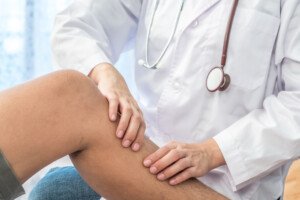
Here’s reassurance for those terrified of what their calf twitches, dents and cramps might mean.
Calf cramps, calf twitches, and calf dents are extremely common.
They are so common that few people talk about calf dents or calf twitches.
However, people DO talk about calf cramps because muscle cramps can be very painful.
It’s common for calves to cramp (as well as twitch or have dents), and there is no reason to think it’s ALS.
I’m a former certified personal trainer and have had many clients with lower leg cramps. Our goal was to increase the client’s dents!
A muscle dent that wasn’t there before was joyful news! This meant new muscle definition!
And that’s exactly what calf dents are: muscle definition you never noticed before.

Calves are a common location for harmless dents and grooves. Shutterstock/Jasminko Ibrakovic
Muscle definition can come and go, and this explains why you may be seeing something that you know for a fact wasn’t always there.
Muscle definition can come and go, because body composition often fluctuates due to changes in diet and physical activity.
There are two major calf muscles: the gastrocnemius and the soleus.
These are major force-production muscles that take a good beating in that they are used constantly in our daily lives.
Thus, it’s no surprise, including to orthopedic doctors, that the calf muscle group often tightens up — so much that it cramps and causes pain.
If you’re fearful of ALS, ask yourself how many times in your life so far, that:
1) You’ve had calf cramps in the past and thought nothing of them other than the annoyance, and
2) You knew someone who complained of calf cramps, but then years later, that person was still up and about and perfectly healthy.
Calf cramps are caused primarily by tight muscles, plain and simple.
Fitness experts see this all the time. Few people include calf stretching in their exercise routine.

Calf stretch. Freepik.com, katemangostar
If you use a gym, observe people stretching out.
- How many are stretching their calf muscles?
- It’s a very neglected muscle as far as being stretched on a routine basis.
- You’re probably guilty of this neglect, and thus, you have the cramps.
- Don’t panic with thoughts of ALS.
Another cause of the cramping is a lack of warm-up. And then there is simply being out of condition.
“Tight, contracted muscles can build up lactic acid,” says Carolyn Dean, MD, ND, medical advisory board member of the Nutritional Magnesium Association at nutritionalmagnesium.org.
“Lactic acid buildup produces pain and inflammation. This can happen to athletes and it’s why they often have to put ice on their muscles after a hard workout.”
Lack of hydration and an imbalance in calcium, potassium and magnesium can also cause lower leg cramps.
“Magnesium and calcium work together to make muscles move properly,” explains Dr. Dean.
“Magnesium guards the mineral channels that allow calcium to enter and leave a muscle cell.
“Calcium causes the muscle to contract and then it’s supposed to leave the cell.
“If there isn’t enough magnesium to push calcium out of the cell, you can get excessive muscle contraction.”
And that contraction is the twitching. Calves very commonly twitch. It’s the muscle speaking to you:
- I need a rest
- I need some water
- You are stressed; I’m here to help you run away from danger.
- I need more magnesium.
Calves may twitch due to anxiety, fatigue and exercise. Lactic acid buildup from exercise a day or two preceding a bout of twitching may be responsible for the twitching. Don’t let it alarm you.
Dr. Dean says, “Besides keeping calcium under control, magnesium is also responsible for reducing lactic acid buildup.
“You can soak in an Epsom salts bath or take magnesium citrate in water to reduce lactic acid.”
Muscle twitching can be very persistent and annoying, but as long as you are effortlessly able to walk or skip from Point A to Point B, there’s no reason to fear ALS.
DENTS!
Dents are part of your body’s normal muscle topography. Your legs are not filled with air. They are filled with muscle, many strips of muscle tissue.

Many visible dents. Shutterstock/Free around

More dents.
If you removed your skin, you’d see exactly what was causing the dents, fissures and grooves.
This is your anatomy showing through your skin. It will not be equal on both sides of your body.
Thus, a dent on one calf and not the other (with no weakness) does not mean you have ALS.
View an anatomy chart of the human body showing all the muscles. Study the calf region.
The way the various lower leg muscles overlap and merge with each other clearly explains why you see dents.
Please get some sleep tonight and stop punishing yourself with ALS fears.
You will probably be just fine. Drink plenty of water, stay away from full-length mirrors, wear long tight pants to discourage visual inspections for dents, and realize you are just like everyone else.

Dr. Dean, in practice for 35+ years and author of “The Magnesium Miracle,” is also a naturopath, nutritionist, herbalist, acupuncturist, lecturer and consultant.
 Lorra Garrick has been covering medical, fitness and cybersecurity topics for many years, having written thousands of articles for print magazines and websites, including as a ghostwriter. She’s also a former ACE-certified personal trainer.
Lorra Garrick has been covering medical, fitness and cybersecurity topics for many years, having written thousands of articles for print magazines and websites, including as a ghostwriter. She’s also a former ACE-certified personal trainer.
.













